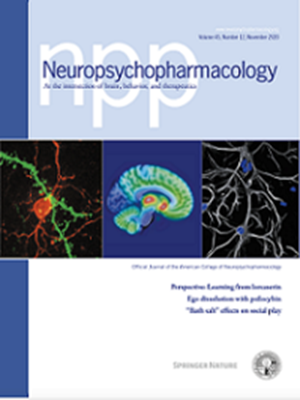The activation of the piriform cortex to lateral septum pathway during chronic social defeat stress is crucial for the induction of behavioral disturbance in mice
IF 6.6
1区 医学
Q1 NEUROSCIENCES
引用次数: 0
Abstract
Chronic stress induces neural dysfunctions and risks mental illnesses. Clinical and preclinical studies have established the roles of brain regions underlying emotional and cognitive functions in stress and depression. However, neural pathways to perceive sensory stimuli as stress to cause behavioral disturbance remain unknown. Using whole-brain imaging of Arc-dVenus neuronal response reporter mice and machine learning analysis, here we unbiasedly demonstrated different patterns of contribution of widely distributed brain regions to neural responses to acute and chronic social defeat stress (SDS). Among these brain regions, multiple sensory cortices, especially the piriform (olfactory) cortex, primarily contributed to classifying neural responses to chronic SDS. Indeed, SDS-induced activation of the piriform cortex was augmented with repetition of SDS, accompanied by impaired odor discrimination. Axonal tracing and chemogenetic manipulation showed that excitatory neurons in the piriform cortex directly project to the lateral septum and activate it in response to chronic SDS, thereby inducing behavioral disturbance. These results pave the way for identifying a spatially defined sequence of neural consequences of stress and the roles of sensory pathways in perceiving chronic stress in mental illness pathology.

慢性社会失败应激过程中梨状皮质向外侧隔膜通路的激活是诱导小鼠行为障碍的关键。
慢性压力会导致神经功能障碍,并有患精神疾病的风险。临床和临床前研究已经确定了大脑区域在压力和抑郁中潜在的情绪和认知功能的作用。然而,神经通路感知感官刺激作为应激引起的行为障碍尚不清楚。利用Arc-dVenus神经元反应报告小鼠的全脑成像和机器学习分析,我们公正地证明了广泛分布的大脑区域对急性和慢性社会失败应激(SDS)神经反应的不同贡献模式。在这些脑区中,多个感觉皮质,特别是梨状(嗅觉)皮质,主要有助于对慢性SDS的神经反应进行分类。事实上,SDS诱导的梨状皮质激活随着SDS的重复而增强,并伴有气味辨别能力受损。轴突示迹和化学发生操作表明,梨状皮质的兴奋性神经元直接投射到外侧隔膜,并在慢性SDS下激活它,从而诱发行为障碍。这些结果为确定压力的神经后果的空间定义序列和感觉通路在精神疾病病理中感知慢性压力的作用铺平了道路。
本文章由计算机程序翻译,如有差异,请以英文原文为准。
求助全文
约1分钟内获得全文
求助全文
来源期刊

Neuropsychopharmacology
医学-精神病学
CiteScore
15.00
自引率
2.60%
发文量
240
审稿时长
2 months
期刊介绍:
Neuropsychopharmacology is a reputable international scientific journal that serves as the official publication of the American College of Neuropsychopharmacology (ACNP). The journal's primary focus is on research that enhances our knowledge of the brain and behavior, with a particular emphasis on the molecular, cellular, physiological, and psychological aspects of substances that affect the central nervous system (CNS). It also aims to identify new molecular targets for the development of future drugs.
The journal prioritizes original research reports, but it also welcomes mini-reviews and perspectives, which are often solicited by the editorial office. These types of articles provide valuable insights and syntheses of current research trends and future directions in the field of neuroscience and pharmacology.
 求助内容:
求助内容: 应助结果提醒方式:
应助结果提醒方式:


